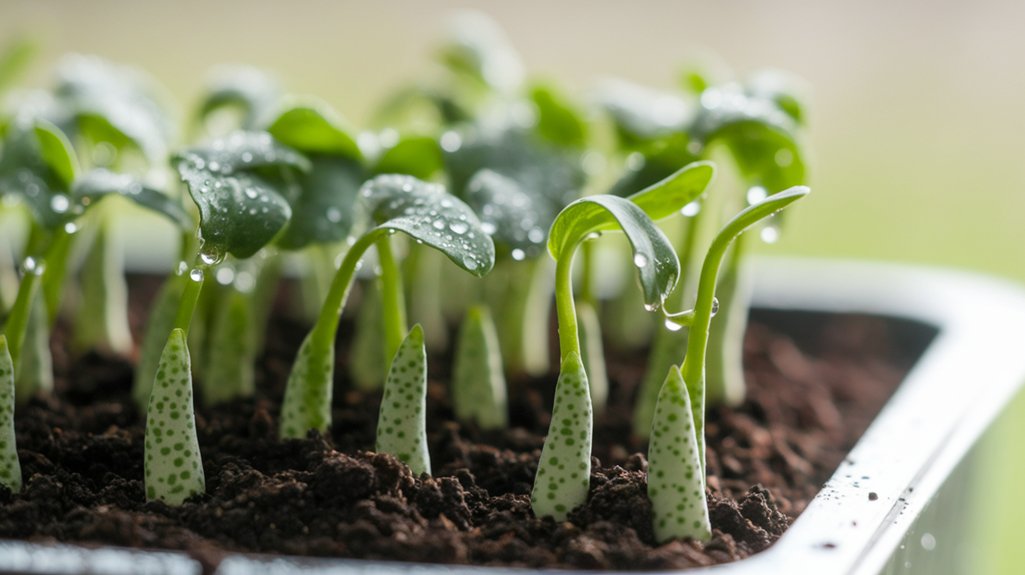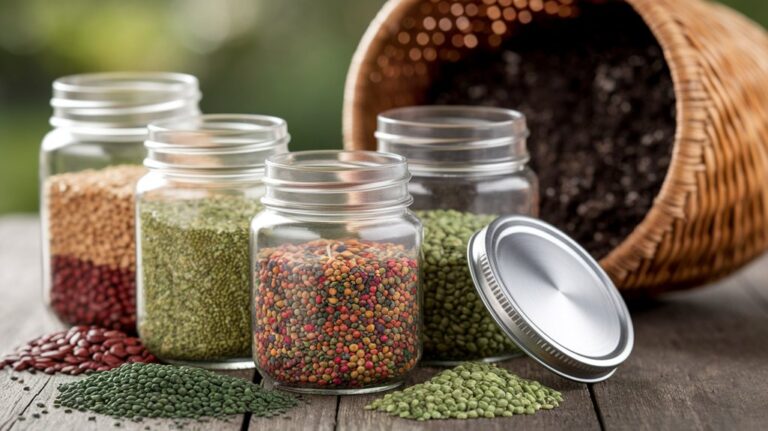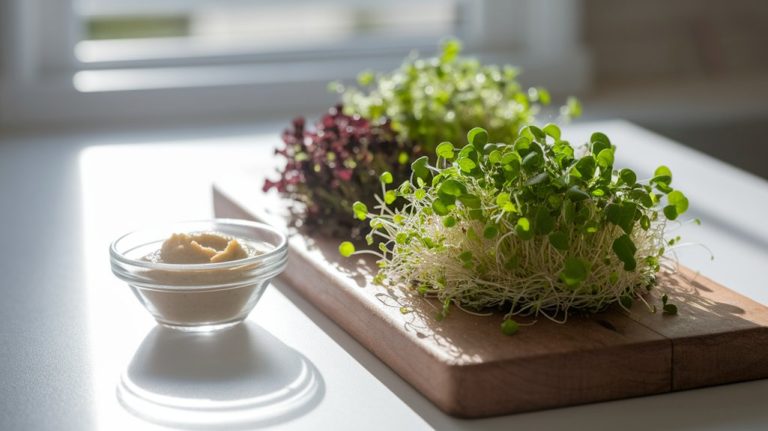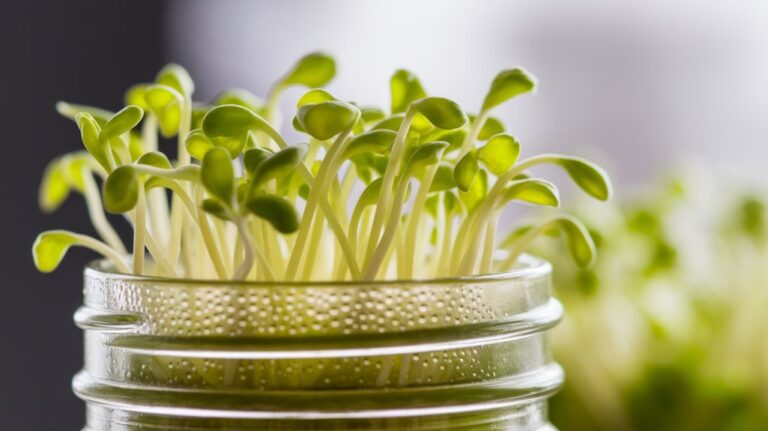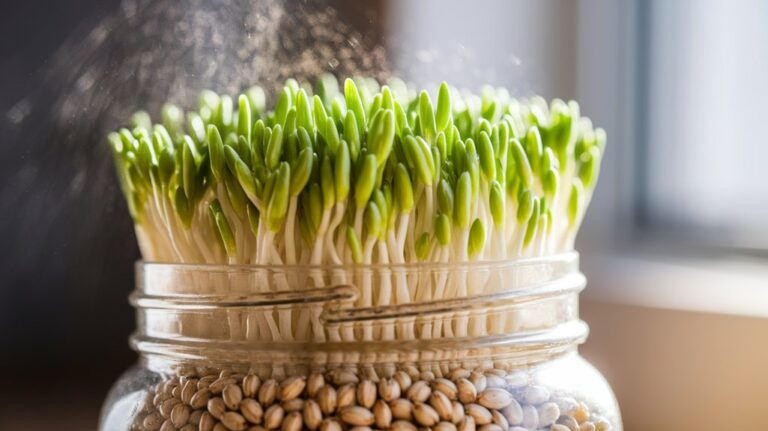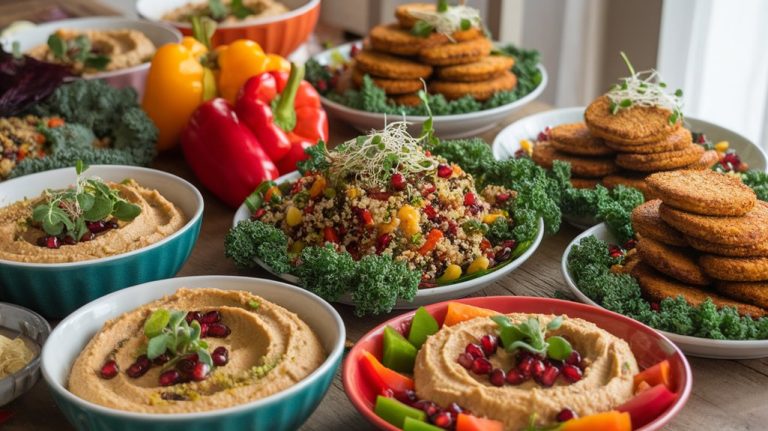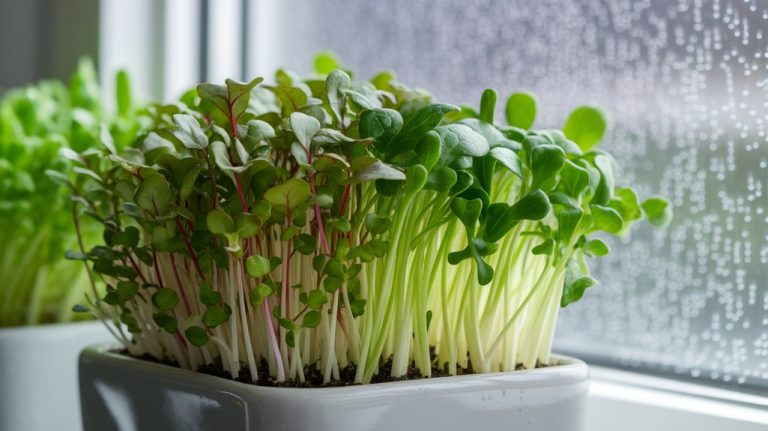How to Sprout Speckled Peas
To sprout speckled peas, I first rinse them thoroughly and then soak them in cool water for 8 to 12 hours. After soaking, I drain and rinse the peas again, transferring them to a sprouting jar or container. I cover the jar with a breathable cloth and rinse the seeds twice daily, keeping them moist. In about 3 to 5 days, I see little sprouts emerge, enhancing my meals’ nutrition and flavor. There’s more I can share about using these sprouts creatively!
Key Takeaways
- Choose high-quality, organic speckled peas, ensuring they are free from damage and suitable for sprouting.
- Rinse the peas to remove debris, then soak them in cool water for 8 to 12 hours.
- After soaking, drain and rinse the peas again to eliminate any residual substances.
- Place the peas in a sprouting jar or container, covering it with a breathable cloth for air circulation.
- Rinse the peas twice daily and keep them moist for 3 to 5 days until sprouts appear.
What Are Speckled Peas?
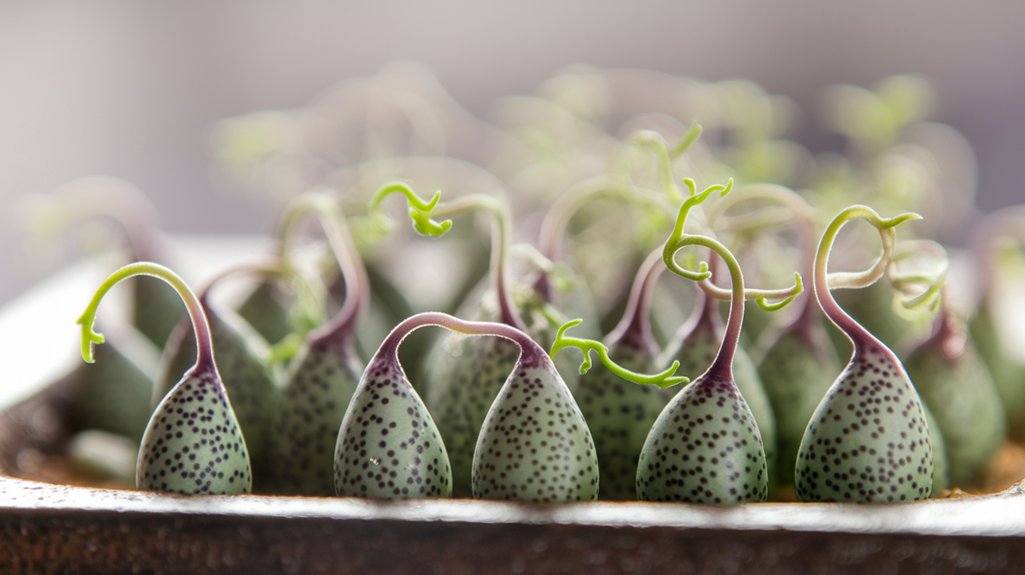
Speckled peas are a unique variety of legumes known for their distinct mottled appearance, which features a blend of green and purple hues. These peas belong to the Pisum sativum species and are often cultivated for their culinary versatility.
I’ve found that they thrive in cool climates and are typically harvested in late spring or early summer. The seeds possess a firm texture and a slightly sweet flavor, making them an excellent addition to various dishes.
Nutritionally, speckled peas are rich in protein, fiber, and essential vitamins, contributing to a balanced diet. When it comes to cooking, they require soaking to soften before incorporation into recipes.
Understanding their characteristics helps in maximizing their potential in the kitchen.
Benefits of Sprouting Speckled Peas
Sprouting these peas offers a range of nutritional benefits that enhance their already impressive profile.
When I sprout speckled peas, I notice a significant increase in vitamins, particularly vitamin C and several B vitamins. The sprouting process also boosts the protein content and makes amino acids more bioavailable, which is essential for muscle repair and overall health.
Additionally, the digestibility of these peas improves, reducing anti-nutritional factors like phytic acid. This means my body can absorb more minerals, such as iron and zinc, effectively.
I also appreciate that sprouted peas are lower in calories while being high in fiber, promoting digestive health.
Choosing High-Quality Peas
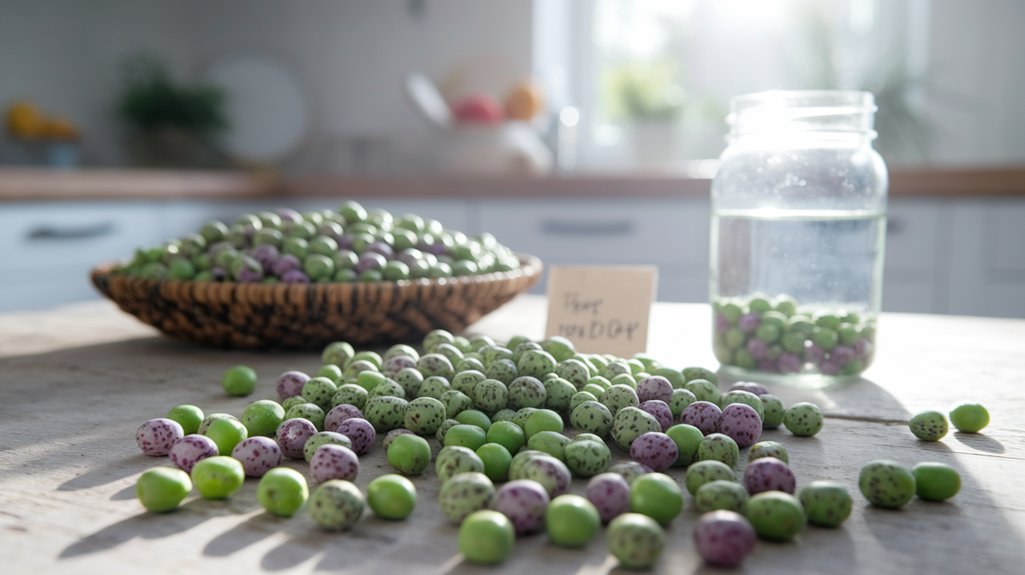
When I select peas for sprouting, I always prioritize high-quality seeds to ensure optimal growth and nutrition.
I look for organic, non-GMO speckled peas, as they often have better germination rates and nutritional profiles. It’s crucial to check the packaging for a recent harvest date; older seeds may have reduced viability.
I also examine the seeds for any signs of damage or discoloration. Healthy peas should be firm and free from mold or pests.
Additionally, I prefer seeds that have been specifically labeled for sprouting, as they undergo less processing and are more likely to germinate successfully.
Preparing the Peas for Sprouting
To prepare speckled peas for sprouting, I focus on selecting high-quality seeds that are free from damage and disease.
Next, I explain the soaking process, which is essential for activating the seeds.
Finally, I ensure I store the seeds under ideal conditions to maintain their viability before sprouting.
Selecting Quality Seeds
Selecting quality seeds is crucial for successful sprouting, as the health and vitality of the peas directly influence the outcome.
When I choose seeds, I focus on a few key factors:
- Appearance: I inspect the seeds for uniformity in size and color. Healthy speckled peas should be plump and free of blemishes.
- Source: I prefer buying from reputable suppliers who specialize in organic or heirloom varieties, ensuring I get quality seeds.
- Freshness: I always check the packaging date. Fresher seeds have a higher germination rate, so I avoid old or expired seeds.
Soaking Process Explained
Soaking the speckled peas is a vital step in the sprouting process, as it initiates hydration and activates the seeds.
I typically start by rinsing the peas thoroughly to remove any debris. Then, I place them in a bowl and cover them with fresh, cool water. It’s essential to use enough water to ensure the peas are fully submerged, allowing for even absorption.
I usually let them soak for about 8 to 12 hours, which helps soften the seed coat and jumpstarts germination. After soaking, I drain the peas and rinse them again to remove any residual substances.
This step is crucial for preparing them for optimal sprouting, setting the foundation for healthy growth.
Ideal Storage Conditions
While preparing speckled peas for sprouting, it’s crucial to consider their storage conditions to ensure optimal growth.
I’ve found that proper storage can significantly impact germination rates and overall health. Here are the ideal conditions to keep in mind:
- Temperature: Store the peas in a cool, dark place, ideally between 50-60°F (10-15°C). Avoid direct sunlight, as heat can damage the seeds.
- Humidity: Aim for a low humidity environment to prevent mold growth. Using breathable containers, like paper bags, helps maintain this balance.
- Airflow: Ensure adequate airflow around the peas. This prevents moisture buildup and promotes healthy seed viability.
The Sprouting Process
To initiate the sprouting process for speckled peas, I first rinse the seeds thoroughly to remove any debris or contaminants.
Next, I soak the seeds in clean, cool water for about eight hours. This hydration activates the seeds and prepares them for germination.
After soaking, I drain the water and transfer the seeds into a sprouting jar or container, ensuring they’re evenly spread out. I then cover the jar with a breathable cloth or lid, allowing air circulation while preventing contamination.
Over the next few days, I rinse the seeds with fresh water twice daily, keeping them moist but not waterlogged.
Within three to five days, I observe tiny sprouts emerging, signaling successful germination.
Tips for Maintaining Healthy Sprouts
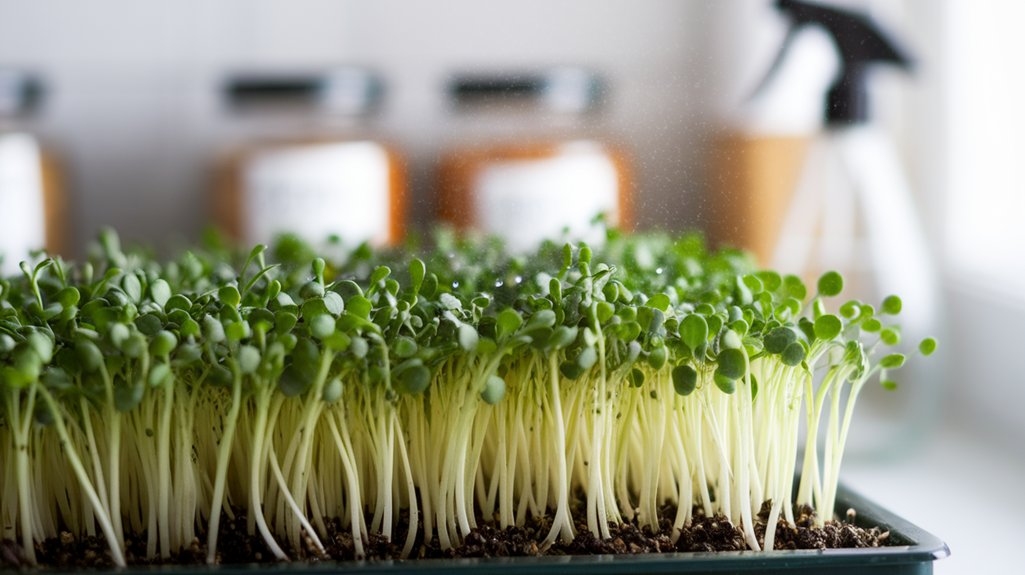
Maintaining healthy sprouts requires consistent attention to their environment and moisture levels.
I’ve found that following a few key practices can significantly enhance the growth of my speckled peas.
Here are three essential tips:
- Moisture Control: Keep the sprouts evenly moist but not soggy. I rinse them twice daily with fresh water to maintain optimal moisture levels.
- Light Exposure: Once the sprouts are a few days old, I place them in indirect sunlight. This encourages healthy chlorophyll development without overheating them.
- Air Circulation: I ensure good airflow around my sprouts by using a mesh lid or covering. This helps prevent mold growth and promotes robust development.
Creative Ways to Use Sprouted Peas in Your Meals
Sprouted peas are a versatile ingredient that can elevate a variety of dishes. I love incorporating them into salads for a crisp texture and a nutrient boost.
Their mild, sweet flavor works well in grain bowls, where they add both color and crunch. You can also blend sprouted peas into smoothies for an extra protein kick.
I often sauté them with garlic and olive oil as a simple side dish; they cook quickly and retain their vibrant green color. Additionally, I’ve experimented with adding them to stir-fries, where they maintain their crunch amidst the other vegetables.
Lastly, toss them into soups just before serving for a fresh finish. These methods showcase their adaptability and enhance the nutritional profile of any meal.
Frequently Asked Questions
Conclusion
In conclusion, sprouting speckled peas is a rewarding process that enhances their nutritional profile and adds a delightful crunch to your meals. By selecting high-quality peas and following the outlined sprouting steps, you can easily cultivate these nutritious gems at home. Remember to maintain proper conditions for optimal growth, and don’t hesitate to explore creative ways to incorporate your sprouted peas into a variety of dishes. Happy sprouting, and enjoy the benefits of this wholesome addition to your diet!

